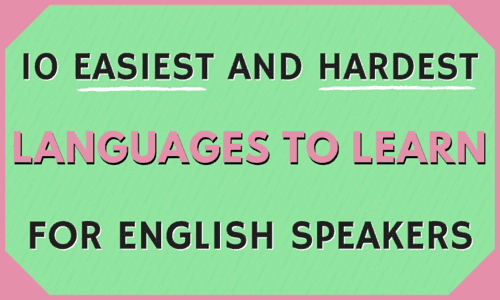Every language requires a different learning approach. Depending on how easy or hard a language is to learn, you can have varying practice times, materials, and degrees of discipline. In this article, you’ll learn about 10 popular languages and their difficulty levels from our language learning friend, Julie Petersen.
Here’s a list of the 10 easiest to hardest languages to learn!
Language difficulty is a hard thing to calculate. It really depends on a variety of factors, such as personal motivation and interest, desire or need, surrounding culture, and even psychological barriers. Everyone is unique, so it’s not going to be the same experience for every individual; it all depends on your perspective and personal intelligence level.
The best approach is to keep an open mind and to have realistic expectations. In other words, do not expect to be fluent in a new language within one week (but don’t limit yourself either).
While a lot of what goes into learning a language certainly has to do with yourself, from your level of commitment to your willingness to practice and study, there are some languages that are innately easier to learn than others. You may find some languages are actually similar to your native language, while others have complex grammar rules and maybe even their own alphabets. You will find every language has its quirks, but you may be interested in discovering the easiest and hardest language to learn for English speakers.
If you’re looking to add another language to your belt, then it’s time to choose which language to tackle next. With roughly 6,500 languages spoken around the world, you have a lot of choices! To help you narrow down your options, we’ve provided a handy list ranking the easiest languages to learn, followed by the most difficult to learn.
To help you narrow down your options, we’ve provided a handy article ranking the list of easiest to hardest languages to learn!
Which Language is the Hardest to Learn?
Mandarin is often considered the most difficult language to master. However, these languages are often considered quite difficult, too:
- Hungarian
- Bulgarian
- Serbian
- Turkish
- Albanian
- Greek
- Farsi
- Vietnamese
- Russian
- Hindi
- Thai
- Japanese
- Korean
- Arabic
Finnish, Cantonese Chinese, Czech, Mongolian, Icelandic, Urdu, and Finnish are also included as tough languages on the easiest to hardest languages to learn lists!
Here’s a video explaining more of the easiest to hardest languages to learn:
What Makes a Language Hard to Learn?
When trying to figure out the easiest and hardest languages for English speakers to learn, consider the following characteristics.
Grammatical Concepts
Does the new language have a grammatical structure that is similar to the native language – in this case, English? Are there gender concepts you’ll need to master? Differences in verb tense or word order? The closer the new language is in grammatical structure to the native language, the easier it will be to learn.
Sounds
Are there similar or identical sounds in the new language or are these unique? Does the new language use tones, or different infections of the same sound to confer a new meaning? If the latter is true, this can make learning a new language more challenging.
Writing System
When deciding the easiest to hardest languages to learn, you’ll also need to consider the writing system. If there is an entirely different alphabet or a differently organized script (such as writing right to left instead of left to right, as English writers are used to), the new language will be more challenging to learn.
Cultural Similarities
If there are any cultural similarities between the new and existing language, this, too, will make it easier to learn. Significant cultural differences can make language concepts more challenging since the context needed to understand those differences is often missing.
Resources
How easy will it be for you to access resources to learn this new language? Can you find things like movies, books, newspapers, and music easily in your area? This is what makes learning ancient or rare languages so challenging – often, it’s too difficult to truly immerse yourself in a language, so learning the new tongue is nearly impossible at times.
Family
Finally, consider whether the new language belongs to your language family. If there are easily identifiable vocabulary words, loan words, and cognates, it will make the new language far easier to learn.
What is the Easiest Language in the World?
Our list is in order from the easiest to hardest languages to learn. It begins with languages that you can master in several months and leads into the more complex languages that could take you years to reach proficiency.
Check out our list below of the 10 easiest and hardest languages for English speakers to learn and get started on your language learning today!
*The languages in both of these lists are in no particular order
1) Danish
When you’re differentiating between some of the easiest and hardest languages to learn, you will likely stumble upon the Danish language. This Scandinavian language is grammatically easy and has only nine verb forms, including the passive, which is familiar to English speakers. It has a lot of Germanic-based vocabulary and unique speaking patterns, which are quick and soft. Most motivated native English speakers should be able to achieve a basic level of fluency within 6 months (depending on how often you study).
2) French
French is often considered the language of love. However, this romance language is difficult for many English speakers to pronounce. There are more verb forms (17 as compared to English’s 12) and it uses gendered nouns as well. However, French’s Latin origins make much of the vocabulary easy to learn. It has more in common with English than any other romance language. With regular classes and determination, you may have basic French fluency within as little as 3 months.
3) Italian
As soon as you hear this language spoken, there’s a good chance you’ll want to speak it, too! Regarded as one of the most beautiful-sounding languages in the world, Italian is a romance language that is written as it sounds, making it easy to learn. Once the initial phonemes (units of sound) are understood, the reading becomes natural. The words tend to end in vowels, which give it fun style. Grammatically, the language follows romance language structure. Italian also has fewer verbs than French or Spanish. For native English speakers, this is a similar learning time-frame as French, or the other romance languages.
4) Portuguese
There are fewer prepositions in Portuguese than in English, but their uses are not always the same as in English. This means they can be easy to remember, but also hard to implement. The interrogatives (like ‘how’ or ‘what’) are really easy in Portuguese as well. Pronunciation is usually not too difficult for English speakers, which earns it a spot in our list of the easiest languages to master. With regular practice, basic fluency can be achieved within 3-6 months.
5) Spanish
When ranking the easiest languages to learn, we can’t forget about Spanish. Spanish pronunciation is fairly easy for English speakers and it only has ten vowel sounds (compared to English’s 20). It has a few new letters to learn, but they’re simple (just like Italian). Words are written as they sound and Spanish follows its own rules with fewer irregularities than other romance languages. Spanish is one of the most common second languages for English speakers to learn. A basic level of fluency can be accomplished within 3-6 months.
Hardest Languages
Here are some more of the hardest languages to learn ranked, from easiest to hardest,
1) Arabic
If you’re looking for a challenge, then you may want to set your sights on the Arabic language. Most Arabic letters have four different versions. Choosing the correct form depends on where the letter is placed in a word – and the vowels are not included when writing either. This makes learning the language (and translating it) much more difficult for English speakers. “Nobody serious about the language imagines that approaching fluency can be achieved in anything less than a year, even while living in an Arabic-speaking country,” writes a user from LonelyPlanet.com.
2) Mandarin
Mandarin is a Chinese language that is often referred to as the most difficult to learn. Some will even categorize it under the top 50 hardest languages to learn. Experts estimate that it’ll take 2,200 class hours to achieve proficiency. This is due to its tonal sound and abundance of characters, words, and rules. The language has a long history and every sound in Mandarin’s phonetic writing system has four different pronunciations.
3) Japanese
When it comes to the easiest and hardest languages to learn, Japanese is certainly ranked on the more difficult end as it’s riddled with complexities. It’s alphabet and characters alone can send you into a doozy. Japanese has a character-based system, but this includes thousands of characters that must be learned before you can write at any decent Japanese level. The language has three writing systems as well, and each has its own alphabet; you’d have to learn one new language, but three new alphabets. To be able to hold conversations with other Japanese speakers, it’ll take 2-3 years of practice.
4) Korean
If you search for the top 50 hardest languages to learn for English speakers, you may find Korean gracing that list. Korean is an extremely unique language. It’s so unlike any other that it’s very difficult to absorb naturally (but it’s not as hard as you think). When building a sentence in Korean, the subject goes first, the object second, and the action last. It’s all backwards for English speakers, and when directly translating, sentences sound funny. On average, you’ll need to study at least 2,200 hours before you’re truly fluent in Korean.
5) Icelandic
Icelandic is probably easier for most English speakers, than say, Mandarin. However, it’s still very complex. Less than 400,000 people in the world speak the language and they come from one island. Practicing may be difficult since the language has not changed much since the ninth century. Rather than adopting foreign words, the natives simple recycle old ones. For English speakers, it’ll take an average of 1,100 hours of practice to become fluent.
Tips to Master A New Language – Including all the Easiest to Hardest Languages to Learn!
Regardless of the language you decide to learn, there are a few tips to follow to speed up your language acquisition.
First, have a clear understanding of why you want to learn the language in the first place.
Whether your goal is to be able to become fluent in a language so you can travel and see the world or you just want to be able to understand bits and pieces in basic conversation, it’s important to have a good picture of why you’re doing this in the first place. That motivation will keep you going through the tough spells!
Set Goals
As a corollary point to what we said earlier, make sure you have clear goals in mind as you begin learning.
Break your major goal – ie, to become fluent in Russian – down into many micro-goals. What do you want to accomplish on a daily, weekly, or monthly basis? Start small and remember – even just five or ten minutes a day can go a long way when it comes to keeping a language fresh in your mind.
Focus Only on Critical Concepts
As you begin learning the language, don’t spend hours upon hours studying things that aren’t crucial to basic understanding.
Follow the 80-20 rule instead. About 80% of your results will come from 20% of your efforts. Don’t be afraid to shoot for the low-hanging fruit and master things like verb tenses, basic vocabulary, and useful phrases first.
Get a Teacher
If you can, find a teacher who will be able to provide you with the fundamental training necessary to grasp key concepts. If getting a teacher isn’t an option for you, find a language partner or a native speaker with whom you can practice your new language daily.
Record Yourself
Speaking a language is often far more difficult than any other aspect of learning a new language – including writing and reading. If you can, record yourself speaking the new language on a consistent basis so you can watch yourself speak and see if there are any issues with your pronunciation.
Immerse Yourself in the Culture of the New Language
The best possible thing you can do is to immerse yourself fully in a new language. That’s not to say that, if you’re trying to learn Turkish, you need to move to Turkey (but props to you if you decide to go that far!).
However watching movies and television shows, listening to radio or music, or reading newspapers and books in the language you’re trying to learn can be hugely helpful.
Languages to Learn: Easiest to Hardest
Now that you know the list of languages from easiest to hardest to learn, it’s time to choose a new foreign language to master!
No matter what language you need or choose to learn, stay positive. It’s never impossible to learn a new language, and chances are good that it will enhance your overall life experiences. Dedicate yourself to practicing and learning, and you will be chatting away in a new language before you know it.
New languages can expand your education and global communication, as well as your career and travel opportunities. You’ll find yourself interacting and engaging with the world in a whole new way.
Hopefully, this list of hardest to easiest languages to learn has been helpful. So use this list, find a private language instructor, and immerse yourself in a new language today!
Mac


















